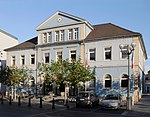Air France Flight 296Q was a chartered flight of a new Airbus A320-111 operated by Air France for Air Charter International. On 26 June 1988, the plane crashed while making a low pass over Mulhouse–Habsheim Airfield (ICAO airport code LFGB) as part of the Habsheim Air Show. Most of the crash sequence, which occurred in front of several thousand spectators, was caught on video.
This particular flight was the A320's first passenger flight and most of those on board were journalists and raffle competition winners, having won tickets as part of a promotional event by local businesses. Many, including several unaccompanied children, had never previously been on an airplane. The low-speed flyover, with landing gear down, was supposed to take place at an altitude of 100 feet (30 m); instead, the plane performed the flyover at 30 ft (9 m), skimmed the treetops of the forest at the end of the runway (which had not been shown on the airport map given to the pilots) and crashed.
All 136 passengers survived the initial impact, but 3 then died of smoke inhalation from the subsequent fire; a quadriplegic boy in seat 4F, a 7 year old in seat 8C, trapped by her seat being pushed forward and struggling to open the seatbelt, and an adult who, according to her partner, had reached the exit with him but then turned back to try help the 7 year old. (The child had been travelling with her older brother but seated apart, he was swept out by a flow of escapees as he tried to find his sister).Official reports concluded that the pilots flew too low, too slow, failed to see the forest and accidentally flew into it. The captain, Michel Asseline, disputed the report and claimed an error in the fly-by-wire computer prevented him from applying thrust and pulling up. Five individuals, including the captain and first officer, were later found guilty of involuntary manslaughter. Captain Asseline, who maintained his innocence, went on to serve ten months in prison and a further ten months probation.This was the first fatal crash of an Airbus A320.








